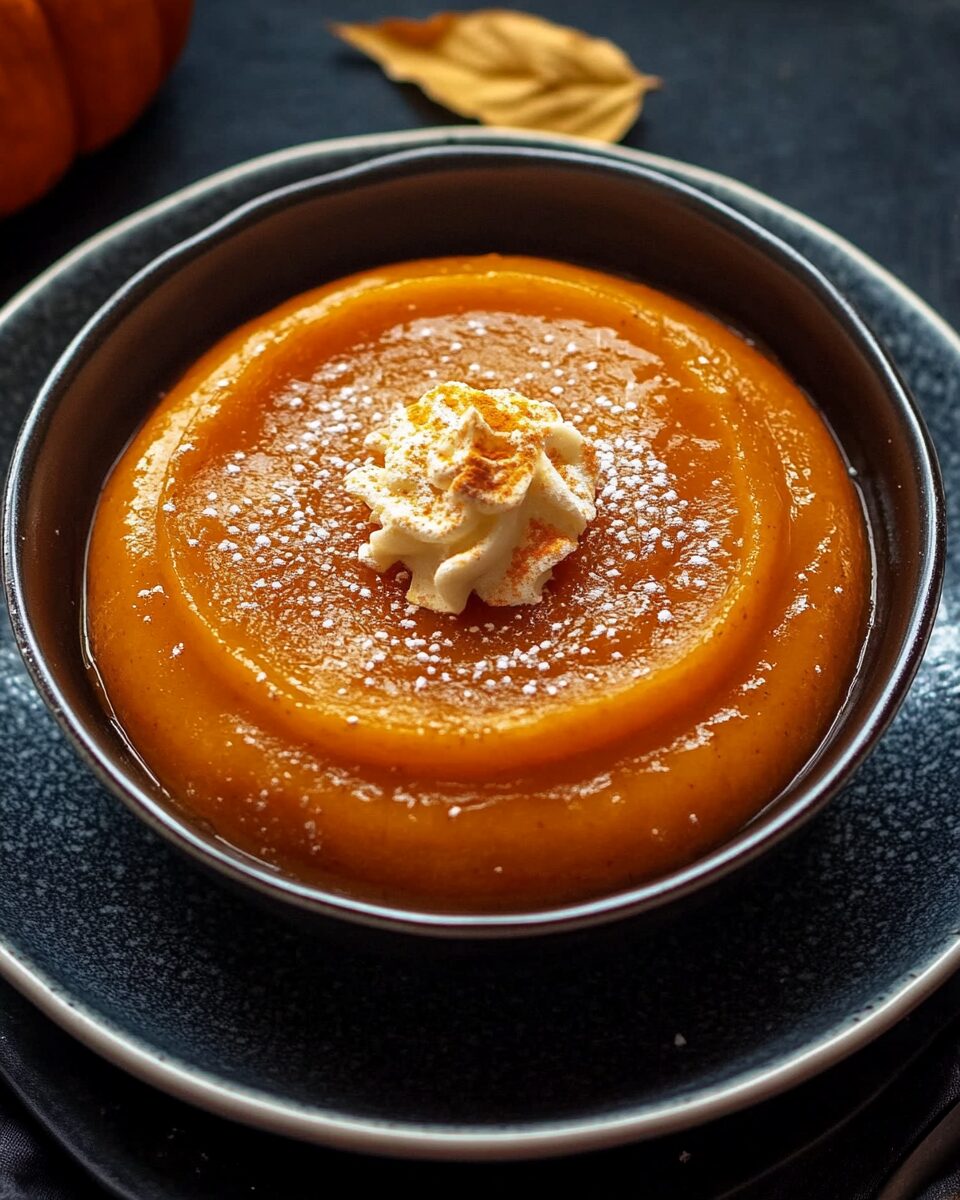Mombasa Pumpkin Dessert is a rich, spiced East African treat that transforms simple pumpkin puree into a decadent, pudding-like dessert. With its blend of cinnamon, nutmeg, and allspice, this baked dish offers warm, comforting flavors perfect for fall or festive occasions. It’s easy to prepare and makes for a delightful end to any meal.
Full Recipe:
Ingredients
- 1 (15 ounce) can pumpkin puree
- 1 (14 ounce) can sweetened condensed milk
- 2 eggs
- 1 teaspoon ground cinnamon
- ½ teaspoon ground nutmeg
- ½ teaspoon ground allspice
- ¼ teaspoon salt
- ½ cup all-purpose flour
- 1 teaspoon baking powder
Directions
- Preheat oven to 350°F (175°C). Grease an 8-inch square baking dish.
- In a large bowl, whisk together pumpkin puree, sweetened condensed milk, and eggs until smooth.
- Stir in cinnamon, nutmeg, allspice, and salt.
- Mix in flour and baking powder until just combined.
- Pour mixture into prepared baking dish.
- Bake for 40 to 45 minutes, or until a knife inserted in the center comes out clean.
- Cool before serving. Best enjoyed chilled or at room temperature.
Nutrients
Estimated per serving (based on 9 servings)
- Calories: 210
- Total Fat: 5g
- Saturated Fat: 2.5g
- Cholesterol: 50mg
- Sodium: 160mg
- Total Carbohydrates: 36g
- Dietary Fiber: 2g
- Sugars: 25g
- Protein: 5g
- Vitamin A: 120% DV
- Vitamin C: 4% DV
- Calcium: 15% DV
- Iron: 6% DV
Cultural Significance
Mombasa is a coastal city in Kenya known for its vibrant history and the intermingling of African, Arab, Persian, and Indian cultures. This blend has given rise to a distinctive culinary identity marked by the use of fragrant spices, tropical ingredients, and slow-cooked methods. The Mombasa Pumpkin Dessert exemplifies this heritage, with its warm spices and soft, pudding-like texture echoing the Indian halwa, yet firmly grounded in African cooking traditions.
Pumpkin itself holds an important place in East African cuisine, often appearing in savory stews, curries, and even breakfast dishes. In this dessert, the pumpkin takes center stage as the main ingredient, enhanced by the richness of condensed milk and the warmth of spices such as cinnamon, nutmeg, and allspice.
This dessert is often served during special occasions, religious holidays, and family gatherings. Its simplicity makes it accessible, while its flavor complexity makes it impressive—a testament to the creativity found in traditional Swahili cooking.
Flavor Profile
What makes the Mombasa Pumpkin Dessert stand out is its unique and memorable flavor. The pumpkin provides a natural sweetness and creamy base, while the condensed milk adds richness and depth. The spices—cinnamon, nutmeg, and allspice—infuse the dish with warmth and a slightly exotic edge that distinguishes it from typical Western pumpkin desserts like pies or breads.
The final texture is somewhere between a pudding and a dense custard, making it deeply satisfying and comforting. Each bite melts in your mouth, releasing layers of sweet and spiced notes. It’s a flavor experience that’s both familiar and novel—comforting like a homemade pie, yet with a touch of the exotic.
Because of this balance, the dessert is incredibly versatile. It can be served as a light end to a heavy meal, a sweet afternoon treat, or even a part of a brunch spread. And while it is traditionally served as-is, it pairs beautifully with accompaniments like whipped cream, spiced tea, or even a scoop of vanilla ice cream.
Texture and Presentation
The visual appeal of the Mombasa Pumpkin Dessert is understated yet elegant. When baked, it develops a subtle golden-brown crust on top while remaining soft and moist inside. The smooth, velvety texture makes it ideal for serving in neat squares or scooped into dessert cups.
Its humble appearance also makes it a canvas for creativity. A light dusting of powdered sugar, a sprinkle of toasted nuts, or a drizzle of caramel can add visual flair without overpowering the dessert’s delicate balance. Presentation can easily be elevated for formal events while remaining simple enough for casual family meals.
A Global Appeal
While this dessert originates from East Africa, its ingredients and preparation resonate globally. Pumpkin is widely available in many parts of the world, and condensed milk is a staple in many kitchens. The spices used are also familiar to anyone who enjoys baking or holiday treats.
This universality makes the Mombasa Pumpkin Dessert a fantastic introduction to Swahili and East African cuisine. For home cooks unfamiliar with African dishes, it offers a way to explore new culinary horizons without needing specialty ingredients or advanced techniques.
Moreover, as interest in world cuisines continues to grow, traditional recipes like this one are finding new audiences eager to discover their unique flavors. Bloggers, chefs, and food enthusiasts are beginning to spotlight recipes that have been passed down through generations, ensuring they are preserved and appreciated by future ones.
Modern Variations and Adaptations
While the original recipe is simple and beautiful in its own right, it can also be adapted in various creative ways to suit different preferences and dietary needs. For example:
- Dairy-Free Version: Swap condensed milk for coconut condensed milk or a mixture of coconut cream and maple syrup for a rich, non-dairy alternative.
- Gluten-Free Option: Substitute the all-purpose flour with a gluten-free flour blend or almond flour to accommodate gluten intolerance.
- Vegan Adaptation: Use flax eggs (1 tbsp flaxseed meal + 2.5 tbsp water per egg) and a plant-based condensed milk to create a vegan version.
- Nutty Twist: Add chopped walnuts or pecans for texture and nutty richness.
- Fruit Additions: Incorporate raisins or chopped dates to bring a sweet, chewy element that complements the pumpkin and spices.
These variations maintain the integrity of the original while offering options for experimentation and personalization. It’s a dessert that welcomes creativity.
Occasions to Serve Mombasa Pumpkin Dessert
Although this dessert is often associated with festive occasions in Mombasa, it fits seamlessly into various celebrations and seasons:
- Thanksgiving or Christmas: Its spiced pumpkin flavor makes it a great alternative to traditional pumpkin pie.
- Ramadan or Eid: As a sweet dish to break the fast or serve after meals, it fits beautifully within celebratory spreads.
- Cultural Potlucks: Bring a unique, crowd-pleasing dish that stands out while honoring East African traditions.
- Fall Gatherings: Highlight seasonal pumpkin in a new and exciting way.
- Everyday Treat: Because it’s easy to make and budget-friendly, it’s also perfect for everyday indulgence.
Health Benefits of Pumpkin-Based Desserts
Pumpkin is not just flavorful—it’s also highly nutritious. Rich in beta-carotene (a precursor to vitamin A), it supports healthy vision, immunity, and skin. It’s also low in calories, high in fiber, and packed with antioxidants.
By using pumpkin as the base, the Mombasa Pumpkin Dessert offers more than just taste—it also provides a dose of nutrients. Even with the inclusion of sweetened condensed milk, which adds sugars and fats, the overall dessert remains a relatively wholesome choice, especially when compared to highly processed or sugar-heavy alternatives.
Serving Tips and Storage
One of the convenient aspects of this dessert is its shelf stability and ease of storage. After baking, it can be cooled and stored in the refrigerator for up to 5 days. The flavors often deepen with time, making leftovers even more delicious.
To serve, simply bring it to room temperature or warm it slightly in the microwave. It can also be served cold, depending on your preference. For large gatherings, the dessert can be doubled and baked in a larger dish, making it ideal for parties or potlucks.
You can also portion it into individual ramekins or cups before baking to create elegant single-serve desserts for formal events.
Conclusion
The Mombasa Pumpkin Dessert is more than just a recipe—it’s a story, a tradition, and a sensory experience. With roots that stretch across cultures and flavors that invite both nostalgia and discovery, it represents the beautiful blend of heritage and innovation in the kitchen.
By combining pantry-friendly ingredients with global appeal and nutritional benefits, this dessert offers something for everyone. Whether you’re serving it to family, friends, or guests unfamiliar with East African cuisine, it’s bound to leave a lasting impression.
Including this dessert on your website not only diversifies your culinary offerings but also honors a rich culinary tradition that deserves recognition and celebration.






